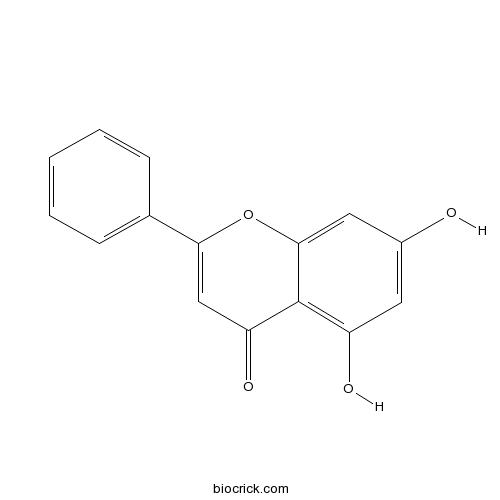Tephroseris kirilowii
Tephroseris kirilowii
1. The products in our compound library are selected from thousands of unique natural products; 2. It has the characteristics of diverse structure, diverse sources and wide coverage of activities; 3. Provide information on the activity of products from major journals, patents and research reports around the world, providing theoretical direction and research basis for further research and screening; 4. Free combination according to the type, source, target and disease of natural product; 5. The compound powder is placed in a covered tube and then discharged into a 10 x 10 cryostat; 6. Transport in ice pack or dry ice pack. Please store it at -20 °C as soon as possible after receiving the product, and use it as soon as possible after opening.
Natural products/compounds from Tephroseris kirilowii
- Cat.No. Product Name CAS Number COA
-
BCN5557
Chrysin480-40-0
Instructions

-
BCN5563
Seneciphylline480-81-9
Instructions

Flavonoids inhibit cell proliferation and induce apoptosis and autophagy through downregulation of PI3Kγ mediated PI3K/AKT/mTOR/p70S6K/ULK signaling pathway in human breast cancer cells.[Pubmed: 30050147]
Anticancer activities of flavonoids derived from Tephroseris kirilowii (Turcz.) Holub. were evaluated in human cancer cells. We isolated and identified, for the first time, eight flavonoids from T. kirilowii and found that three of them (IH: isorhamnetin, GN: genkwanin, and Aca: acacetin) inhibited cell proliferation in a variety of human cancer cell lines. These active flavonoids caused cell cycle arrest at G2/M phase and induced apoptosis and autophagy in human breast cancer cells. Molecular docking revealed that these flavonoids dock in the ATP binding pocket of PI3Kγ. Importantly, treatment with these flavonoids decreased the levels of PI3Kγ-p110, phospho-PI3K, phospho-AKT, phospho-mTOR, phospho-p70S6K, and phospho-ULK. Pretreatment with PI3Kγ specific inhibitor AS605240 potentiated flavonoids-mediated inactivation of AKT, mTOR, p70S6K, ULK, and apoptosis. Taken together, these findings represent a novel mechanism by which downregulation of PI3Kγ-p110 and consequent interruption of PI3K/AKT/mTOR/p70S6K/ULK signaling pathway might play a critical functional role in these flavonoids-induced cell cycle arrest at G2/M phase, apoptosis, and autophagy. Our studies provide novel insights into the anticancer activities of selected flavonoids and their potential uses in anticancer therapy.
Norsesquiterpenoid glucosides and a rhamnoside of pyrrolizidine alkaloid from Tephroseris kirilowii.[Pubmed: 18058377]
Four new glycosylated compounds have been isolated from the whole plant of Tephroseris kirilowii, including (-)-(1R,5R,6S,7R,8S)-8-O-beta-D-glucopyranosyloxy-7-hydroxy-6-(2-hydroxypropan-2-yl)-9-methylenebicyclo[4.3.0]non-3-one (tephroside A, 1), (-)-(1R,5R,6R,8R)-6-(2-O-beta-D-glucopyranosyloxypropan-2-yl)-8-hydroxy-9-methylenebicyclo[4.3.0]non-3-one (tephroside B, 2), thesinine-4'-O-alpha-L-rhamnoside (3), and p-coumaric acid 4-O-alpha-L-rhamnoside (4), together with the known roseoside. The structures of the new compounds were established by means of spectroscopic analysis.


